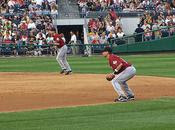The delayed steal (Part 2)
Because a delayed steal is a timing play and mostly will involve runners who are not overly fast (if they were, a straight steal usually would be easier), it becomes imperative for coaches to choose wisely in when they put on the delayed steal. There are only three players a coach needs to pay attention to before deciding: the two middle infielders and the catcher. When watching these players, here are some mistakes to look for.
The Catcher
 |
Occasionally you’ll find a catcher who
drops to a knee during or after the pitch
even with a runner on first base. |
He assumes the runner isn’t going. Many catchers will rely too heavily on his teammates to say “RUNNER!” when a steal is happening. As a result, some catchers relax when they don’t hear anything on the pitch. When a catcher relaxes on the pitch, he usually will lower his rear end as if nobody is on base. This, of course, will make it tougher for him to get up when he finally realizes the runner has taken off. This tends to work even more when a left handed batter is up because the batter’s body will block the catchers ability to see the runner when he ultimately takes off towards second base.
He drops to a knee. Whether they relax as described above or just have a bad habit, some catchers will frequently drop a knee to the ground when they catch pitches with runners on base. If they do, they are prime targets for the delayed steal because once they drop to a knee, it takes too long to get back up in order to throw.
The Middle Infielders
Too far from the bag. Most middle infielders position themselves close enough to second base so as to be able to get to the bag in time on a double-play and/or straight steal. On a straight steal, as soon as the runner at first takes off, the infielder moves as well and usually gets to the bag in plenty of time. However, on a delayed steal, a middle infielder will not know right away that the runner is taking off. If he is too far from the bag, he will not be able to close the distance to the bag in time. Even if the catcher is not fooled and throws to second, the middle infielders are not at the bag to receive the throw if they are positioned too far from the bag on the pitch.
 |
Finding out what these two guys do
before and after the pitch is key. |
Ignoring the runner after the pitch. Just about every middle infielder will take a peek at the runner at first base to see if they take off in a straight steal of second base. However, very few will take another peek just after the pitch to see if the runner is executing a delayed steal. Even worse, some middle infielders will drop their eyes to the ground or even turn their bodies away from second base immediately after the pitch. When these middle infielders realize the runner has taken off on a delayed steal, it will be too late to get to the bag in time.
Note to coaches: If you are one of the base coaches, watching what the middle infielders do immediately after the pitch can put you in a dangerous position. To do this will require you to keep your eyes on the middle infielders as the ball crosses the hitting zone. If the ball is hit, chances are you will not see it off the bat very quickly. When I coach third base and want to gather that information, I stand as far from home plate as I can and angle my body so that I can see the middle infielders if I shift my eyes left and can pick up the pitch if I shift my eyes right. I’ll admit, this may not be the brightest move on my part but I am confident in my ability to get out of the way of a ball hit at me. An easier, safer method for a base coach would be to just have a bench coach or player watch the middle infielders for you.







Leave a Reply